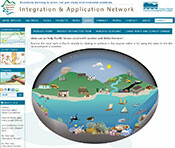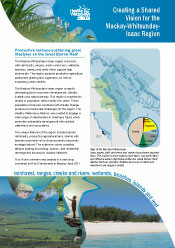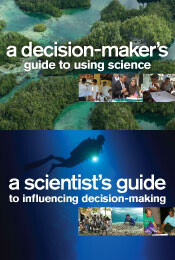Science Communication Intern position available
The Integration and Application Network seeks a science communication intern to join a dynamic group of Science Integrators and Science Communicators to assist in the creation of effective science communication products. This position will support IAN’s goal of not just studying but solving environmental problems through data synthesis and science communication. This internship is targeted to graduate or advanced undergraduate students with backgrounds in science and communication. Sound editing skills and a background in biology or environmental science are required.Natural resource condition assessments for national battlefield parks
 IAN worked with the National Park Service to develop natural resource condition assessments for three national battlefield parks. Habitats within Antietam, Monocacy, and Manassas National Battlefield Parks were defined as being either managed for natural resource values or managed for agricultural values. Habitat maps were created, and desired/degraded conditions were defined for each habitat. Metrics were then assigned to these habitat types compared to established thresholds, leading to the condition assessment for each habitat. Assessed habitats included forests, deer populations, bird diversity, wetlands and waterways, biological stream diversity, pastures, and grasslands.
IAN worked with the National Park Service to develop natural resource condition assessments for three national battlefield parks. Habitats within Antietam, Monocacy, and Manassas National Battlefield Parks were defined as being either managed for natural resource values or managed for agricultural values. Habitat maps were created, and desired/degraded conditions were defined for each habitat. Metrics were then assigned to these habitat types compared to established thresholds, leading to the condition assessment for each habitat. Assessed habitats included forests, deer populations, bird diversity, wetlands and waterways, biological stream diversity, pastures, and grasslands.
Coral reefs and climate change education module
 The Integration and Application Network and the National Park Service Pacific Island Network Inventory and Monitoring Program are pleased to announce the release of the Coral Reefs and Climate Change module. Interactive elements allow students to explore the biodiversity of coral reefs, collect data about coral cover with the same methods used by scientists, see into the future as unchecked carbon emissions increase ocean acidification and erode corals, and imagine how their daily lives would be different without coral reefs. Specifically designed to allow students to choose their experience and observe the topics that are most interesting to them, this web module uses games, videos, and animations to help students observe corals and inspire them to develop their own questions. In addition, teachers can access lessons and activities associated with the module content. Teachers can download state and national teaching standards, learning objectives, materials lists, and worksheets that will allow them to use the module in their classroom.
The Integration and Application Network and the National Park Service Pacific Island Network Inventory and Monitoring Program are pleased to announce the release of the Coral Reefs and Climate Change module. Interactive elements allow students to explore the biodiversity of coral reefs, collect data about coral cover with the same methods used by scientists, see into the future as unchecked carbon emissions increase ocean acidification and erode corals, and imagine how their daily lives would be different without coral reefs. Specifically designed to allow students to choose their experience and observe the topics that are most interesting to them, this web module uses games, videos, and animations to help students observe corals and inspire them to develop their own questions. In addition, teachers can access lessons and activities associated with the module content. Teachers can download state and national teaching standards, learning objectives, materials lists, and worksheets that will allow them to use the module in their classroom.
Creating a Shared Vision for the Mackay-Whitsunday-Isaac Region
 The Mackay-Whitsundays-Isaac region is diverse, with rainforests, ranges, creeks and rivers, wetlands, beaches, islands, and reefs which support high biodiversity. The region supports productive agriculture, particularly grazing and sugarcane, as well as expanding urban centres. The Mackay-Whitsundays-Isaac region is rapidly developing due to economic development, climate, livability, and natural beauty. This region is expected to double in population within twenty-five years. These population pressures combined with climate change produce environmental challenges for the region. The Healthy Waterways Alliance was created to engage a wide range of stakeholders in charting a future which promotes sustainable development with resilient waterways and ecosystems.
The Mackay-Whitsundays-Isaac region is diverse, with rainforests, ranges, creeks and rivers, wetlands, beaches, islands, and reefs which support high biodiversity. The region supports productive agriculture, particularly grazing and sugarcane, as well as expanding urban centres. The Mackay-Whitsundays-Isaac region is rapidly developing due to economic development, climate, livability, and natural beauty. This region is expected to double in population within twenty-five years. These population pressures combined with climate change produce environmental challenges for the region. The Healthy Waterways Alliance was created to engage a wide range of stakeholders in charting a future which promotes sustainable development with resilient waterways and ecosystems.
Science-to-Action Guidebook
 Recognizing the importance of informed decisions and the differences between the scientific and decision-making processes, this guidebook provides practical tips on how to best bring these worlds together. It emphasizes the roles of facilitating, synthesizing, translating, and communicating science to inform conservation action. The two "guides" are combined in one publication: one intended for scientists, and the other for decision-makers. Visit the Science to Action website for printed copies and further information.
Recognizing the importance of informed decisions and the differences between the scientific and decision-making processes, this guidebook provides practical tips on how to best bring these worlds together. It emphasizes the roles of facilitating, synthesizing, translating, and communicating science to inform conservation action. The two "guides" are combined in one publication: one intended for scientists, and the other for decision-makers. Visit the Science to Action website for printed copies and further information.

